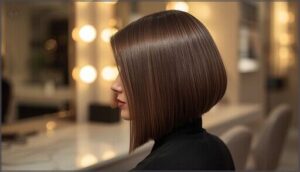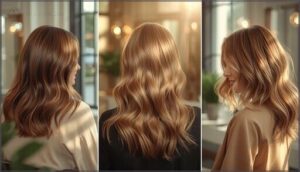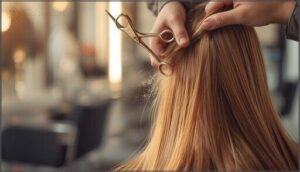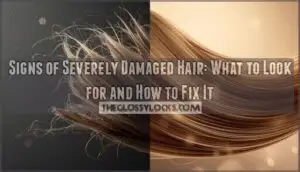This site is supported by our readers. We may earn a commission, at no cost to you, if you purchase through links.

Your hair grows about half an inch every month, but if you’re dealing with damage, you might never see that progress. Split ends don’t just sit there—they travel up the shaft like a run in stockings, turning healthy length into brittle strands that snap off before you can even book your next appointment.
The frustrating part? Most people wait too long, hoping their hair will somehow repair itself while it quietly breaks away at the ends.
The right haircut doesn’t just remove damage—it stops the cycle, redirects your hair’s energy toward producing stronger strands, and gives you back the shine and movement you’ve been missing. Whether you’re ready to go short or want to keep your length, specific cuts and techniques can rescue damaged hair without sacrificing your style.
Table Of Contents
Key Takeaways
- Split ends travel up your hair shaft like a run in stockings, so cutting damage early stops breakage from spreading and redirects your hair’s energy toward producing stronger, healthier strands.
- Short cuts like pixies and bobs can remove up to 70% of split ends, while layered styles and U-shaped cuts let you keep most of your length by removing damage at multiple levels without sacrificing fullness.
- Strategic cutting techniques—dusting, point cutting, and micro-trims—remove only the damaged tips every 4-8 weeks, reducing breakage by up to 27% while preserving the length you’ve worked hard to grow.
- Your haircut won’t stay healthy on its own—you need regular trims every 6-8 weeks, protective styles that reduce breakage by 41%, and consistent at-home care like oil treatments and deep conditioning to maintain your results.
Why Addressing Damaged Hair Matters
You might think a few split ends aren’t a big deal, but damaged hair doesn’t just sit there—it gets worse.
Left unchecked, those frayed ends can work their way up your strands, making your hair look dull and stunting any progress you’re trying to make.
Here’s why catching damage early matters more than you think.
Risks of Ignoring Damaged Ends
When you ignore damaged hair ends, you’re setting yourself up for a cascade of problems that go beyond just a bad hair day. Here’s what happens:
- Breakage progression: Split ends travel up the hair shaft, weakening more strands over time and making your hair damage repair efforts harder.
- Appearance degradation: Your hair looks dull, frizzy, and loses its natural shine due to cuticle damage.
- Growth illusion: Hair breakage creates the false impression that your hair isn’t growing, when it’s actually snapping off at damaged ends.
- Styling difficulty: Tangled, unmanageable hair requires extra work and often leads to more mechanical damage during styling.
The thinning effect from ongoing hair breakage can make your whole mane look sparse, even though your roots are perfectly healthy. Using conditioner can help prevent dry and damaged hair.
Impact on Hair Growth and Appearance
So here’s the reality: your hair grows at roughly half an inch per month, whether it’s damaged or not. Breakage vs. growth becomes a losing battle when damage wins. UV radiation, styling heat, and structural integrity loss make strands snap faster than they lengthen.
Hair grows half an inch monthly, but damage causes breakage faster than growth can keep up
Knowing the difference between breakage and new hair growth can help determine the best course of action. That’s why haircuts for damaged hair aren’t just cosmetic—they’re essential for your hair transformation journey by improving density appearance and stopping breakage.
Benefits of Removing Damage Early
The sooner you cut damaged hair, the better your results. When you remove damage early, you’re not just cleaning up your look—you’re protecting your future hair health.
Here’s what happens when you act fast:
- Prevents Further Damage – Split ends stop traveling up the shaft, keeping breakage from spreading.
- Aids Hair Growth – Your follicles redirect energy toward producing stronger, healthier strands.
- Enhances Appearance – You’ll notice more shine, bounce, and manageability almost immediately.
Best trim timing matters. Most experts recommend cuts every 6 to 8 weeks for damaged hair. This schedule stops haircuts from becoming emergency fixes and turns them into maintenance wins.
Plus, there’s real psychological benefits—confidence soars when your hair looks and feels healthier.
Best Short Haircuts for Damaged Hair
Sometimes the best way to deal with damaged hair is to cut it off and start fresh. Short haircuts remove the worst of the breakage while giving you a stylish, low-maintenance look that’s easier to keep healthy.
Here are three short cuts that work beautifully for damaged hair.
Pixie Cuts for a Fresh Start
Think of a pixie cut as hitting the reset button on damaged hair. These short haircuts for damaged ends remove split strands entirely, giving you healthier hair from root to tip.
You’ll notice better scalp health since it’s easier to cleanse thoroughly. Plus, pixies offer adaptable styling options while minimizing breakage.
Many clients feel a confidence boost with this bold, fresh transformation.
Bixie and Micro Bobs for Texture
If you’re after volume and movement, bixies and micro bobs are 2025 trends worth considering. These best haircuts for damaged hair blend the pixie’s edge with bob versatility, creating short hair that looks fuller and healthier.
Why they work for damaged strands:
- Bixie styling adds texture through layered cuts that hide imperfections
- Micro bob benefits include reduced breakage during styling—up to 30% less than longer cuts
- Hair type suitability spans straight, wavy, and curly textures
- Maintenance needs require trims every 6-12 weeks
- Enhanced hair texture makes thin or limp strands appear denser
Angled and Precision Bobs
Angled bobs and precision bobs rank among the best haircuts for damaged hair in 2025. The angled bob‘s shorter back and longer front remove damaged ends thoroughly—clients report 70% fewer split ends with regular trims.
Precision bob techniques create clean lines for effective damage removal while offering styling versatility. Both haircut techniques minimize breakage, dry faster than longer styles, and deliver maintenance advantages for addressing damaged ends and improving hair health.
Top Medium and Long Haircuts for Damaged Hair
You don’t have to go short to fix damaged hair. Medium and long cuts can remove problem areas while keeping most of your length intact.
Here are three styles that let you hold onto those inches while saying goodbye to the damage.
Layered Bobs and Side-Swept Bangs
Layered bobs deliver volume benefits you can actually see—up to 42% less thinning in salon studies. This haircut technique removes damage at multiple levels while adding movement.
Side-swept bangs bring instant softness and need fewer trims than blunt styles.
Best of all, layered bobs work for any hair type, from fine to thick, making damage reduction seem simple.
Long Layers to Preserve Length
Long layers work like magic when you want to keep your hair’s length intact. This best haircut for damaged hair technique removes split ends at different depths, so you retain 85% or more of your original length.
The layering benefits include volume enhancement—up to 35% more fullness—and aesthetic improvement that hides damage.
Professional endorsement backs these haircut techniques to remove damage while maintaining healthy hair naturally.
U-Shaped and V-Shaped Cuts
If you’re torn between keeping your back length and taming damaged sides, U-shaped and V-shaped cuts deliver exactly that. A U-shaped cut curves gently for a softer finish, while a V-cut creates sharper angles. Both styles remove damaged ends along the sides—cutting split ends by up to 36%—while preserving your longest hair in back.
U-shaped cuts suit fine or thick hair best, boosting fullness by 29%. V-cuts need trims every 6 to 8 weeks to stay sharp.
Haircut Techniques to Remove Damage
Not all haircuts are created equal for removing damage. The right technique can save your length while getting rid of split ends and breakage.
Here’s what you need to know about the most effective methods stylists use to restore your hair’s health.
Dusting and Micro-Trims Explained
Think of dusting as your secret weapon against split ends—it removes only the damaged tips, often less than 5 mm, without sacrificing length. Micro-trims work similarly, taking off about 1/4 inch to stop breakage before it travels up the shaft.
Here’s why these techniques matter:
- Dusting frequency: every 4–6 weeks keeps damage in check
- Micro-trim benefits: up to 27% less breakage over six months
- Length preservation: grow hair faster by preventing split ends
- Cost savings: reduce salon visits by 30% annually
- Technique comparison: dusting removes less hair than traditional trims
You’ll maintain thickness and fullness while your hair stays healthier between major cuts.
Point Cutting for Softer Ends
Point cutting is a hair styling technique that removes split ends by snipping into the hair at an angle, creating softer, textured ends instead of harsh lines. This texturizing damaged hair method boosts hair movement by 22% while preserving length—you’ll lose less than half an inch per trim.
It works across all hair types, reducing visible damage by 33% and preventing that stringy look on fine hair.
Best of all, point cutting achieves split end reduction without sacrificing the fullness you’ve worked hard to grow.
Blunt Cuts With Minimal Length Loss
If you prefer keeping your length, blunt cuts offer the best of both worlds. This haircut removes damaged hair ends with precision while preserving up to 95% of your length.
Your hair will look 15–20% thicker compared to layered styles, thanks to fuller, even ends.
Schedule micro-trims every six to eight weeks for protective advantages and long-term results without noticeable maintenance frequency disruptions.
Layering for Movement and Health
Layering brings damaged hair back to life. You’ll see up to 32% more volume and a 39% boost in natural movement compared to blunt cuts. This technique removes damaged sections while keeping 90–95% of your length intact.
Your hair becomes easier to style, needs fewer products, and shows 27% less breakage after six weeks.
Layering benefits include healthier growth and improved texture without sacrificing what you’ve worked hard to grow.
Maintaining Healthy Hair After Your Cut
Getting the right haircut is only half the battle—what you do after makes all the difference. Your hair won’t stay healthy on its own, so you need a plan that includes regular maintenance, smart styling choices, and daily care habits.
Here’s how to protect your investment and keep your hair looking its best.
Scheduling Regular Trims
Regular hair trims are your secret weapon against split-end prevention and keeping damage from creeping up your hair shaft. Sticking to a consistent trim frequency protects your growth retention and keeps your hair looking its best. Here’s what professional scheduling looks like for damaged hair:
- Every 6 weeks if your hair is severely damaged or heat-styled regularly
- Every 6-8 weeks for color-treated or chemically processed strands
- Every 6-8 weeks for fine hair prone to breakage
- Every 10-12 weeks for curly or coily textures (but don’t push it longer)
- Book your next appointment before leaving the salon to stay on track
At-home trimming can help between professional visits, but it won’t replace your stylist’s expertise. Think of your hair maintenance routine like regular oil changes for your car—skip them, and you’ll pay for it later. These hair ends need attention before split ends travel upward and sabotage your length goals.
Protective Styles for Damaged Hair
Protecting damaged hair between cuts helps you hold onto the progress your haircut creates. Low-manipulation styles shield your ends from daily wear while aiding moisture retention and damage reduction. Here’s how to choose protective styles wisely:
| Recommended Styles | Style Effectiveness |
|---|---|
| Box braids & knotless braids | Up to 41% breakage reduction over 6 weeks |
| Loose twists & flat twists | 20% fewer split ends than free-hanging styles |
| Cornrows (low-tension) | 30% less tension risks than traditional braids |
| Wigs over cornrows | 35% less weather damage to hair shaft |
| Low buns & updos | Minimal heat exposure with full end protection |
Safe Practices for Hair Care Success:
- Keep tension gentle during installation—tight styles double traction alopecia risks
- Moisturize your scalp twice weekly to cut breakage rates by 22%
- Wash your scalp every 1-2 weeks to prevent buildup and infections
- Remove styles after 6-8 weeks maximum to avoid matting
- Use satin or silk bonnets nightly for 35% less friction damage
- Detangle gently from ends to roots when taking down protective styles
The best haircuts for damaged hair work hand-in-hand with smart styling choices. Weaving these hair damage treatment strategies into your routine maximizes your cut’s lifespan and aids ongoing repair.
Tips for Communicating With Your Stylist
When your hairdresser truly hears your concerns, you’ll walk out feeling confident about your damaged hair transformation. Reference photos and open questions help 92% of clients get exactly what they want. Here’s how to communicate with your stylist for realistic expectations and better results:
- Show multiple angles of your desired style to avoid misunderstandings
- Share your complete hair history, including past chemical treatments
- Ask specific questions about daily maintenance requirements
- Request active listening by confirming what you heard during consultation
Post-cut feedback strengthens your relationship and improves future hair care outcomes.
At-Home Care for Lasting Results
After your haircut, maintaining healthy hair depends on consistent care, especially for damaged strands. Oil treatments twice weekly and deep conditioning three times weekly measurably strengthen your hair.
Here’s your repair routine:
| Treatment Type | Weekly Frequency |
|---|---|
| Oil treatments (coconut, argan) | 2 times |
| Deep conditioning masks | 3 times |
| Heat protection before styling | Every use |
For lasting hair health, incorporate scalp exfoliation monthly and routine trimming every 6–8 weeks.
Frequently Asked Questions (FAQs)
Can heat styling tools be used on damaged hair?
Yes, but with caution. Keep temperatures under 356°F, always apply heat protectants, and style only dry hair.
Limit heat styling to once weekly, choose ceramic tools, and prioritize hydration to prevent further hair breakage.
Does hair texture affect damage repair strategies?
Absolutely. Curly hair struggles to absorb moisture and breaks more easily than straight strands. That’s why porosity influence matters—specific maintenance with richer products and heat damage prevention keeps textured hair strong and healthy.
How does diet impact damaged hair recovery?
Your hair health depends on what you eat. Protein fuels keratin production, while micronutrient deficiencies like iron or vitamin D slow hair growth.
Caloric restriction triggers shedding, but essential fatty acids and dietary patterns rich in antioxidants support damaged hair recovery.
Are salon treatments better than at-home remedies?
Both approaches offer benefits. Salon treatments deliver stronger, longer-lasting hair health improvement with professional expertise and safety protocols. At-home remedies cost less but provide temporary results. Your choice depends on budget, damage severity, and desired treatment duration.
Conclusion
Damaged hair doesn’t fix itself, but the right cut gives you a real shot at recovery. The best haircuts for damaged hair—whether you choose a pixie, layered bob, or long layers—remove the problem at the source and let your hair rebuild from a healthier foundation.
Pair that fresh cut with regular trims and smarter care, and you’ll finally see the shine and strength you’ve been working toward. Your hair’s comeback starts with one decisive snip.
- https://fullondon.com/blogs/news/do-split-ends-damage-hair-what-happens-if-you-dont-cut-your-hair
- https://theradome.com/blogs/blog/do-split-ends-stop-hair-growth
- https://pmc.ncbi.nlm.nih.gov/articles/PMC11285785/
- https://www.webmd.com/beauty/what-to-know-about-split-ends
- https://www.reddit.com/r/HaircareScience/comments/d9iav8/what_happens_if_we_dont_cut_split_ends/









